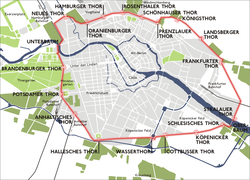The Federal Ministry for Digital and Transport (German: Bundesministerium für Digitales und Verkehr, pronounced [ˈbʊndəsminɪsˌteːʁiʊm fyːɐ̯ diɡiˈtaːləs ʊnt fɛɐ̯ˈkeːɐ̯] (listen)), abbreviated BMDV, is a cabinet-level ministry of the Federal Republic of Germany. Its main office is located in Berlin, while the majority of its civil servants and employees work in Bonn, the secondary seat.
The Ministry itself has about 1300 employees. At the top is the Federal Minister, and there are two Parliamentary Secretaries, who are also Member of the Bundestag, and two civil servant undersecretaries. The ministry oversees 63 downstream agencies and authorities where around 25,000 people work.The agency was formed through the merger of the former Federal Ministry of Transport and the Federal Ministry of Regional Planning, Building and Urban Development, both established in 1949. The merged ministry was at first named Federal Ministry of Transport, Building and Housing until it adopted the name Federal Ministry of Transport, Building and Urban Development (BMVBS) in 2005. On December 17, 2013, it was renamed to Federal Ministry of Transport and Digital Infrastructure (BMVI) through an organizational decree by the Merkel III Cabinet. A decree issued by Olaf Scholz upon assuming chancellorship on December 8, 2021, lead to the ministry receiving its current designation.After German reunification, politicians from the New states of Germany often headed the ministry, which had large responsibility over rebuilding the crumbling infrastructure left over from former East Germany. Günther Krause was the first minister after the 1990 German federal election and in 2002, former Minister-President of Brandenburg Manfred Stolpe was appointed, after his successor as Minister-President, then-Mayor of Potsdam Matthias Platzeck had refused the job in 1998. Stolpe was succeeded by then-Mayor of Leipzig Wolfgang Tiefensee, who had refused the job similarly to Platzeck in 2002.











